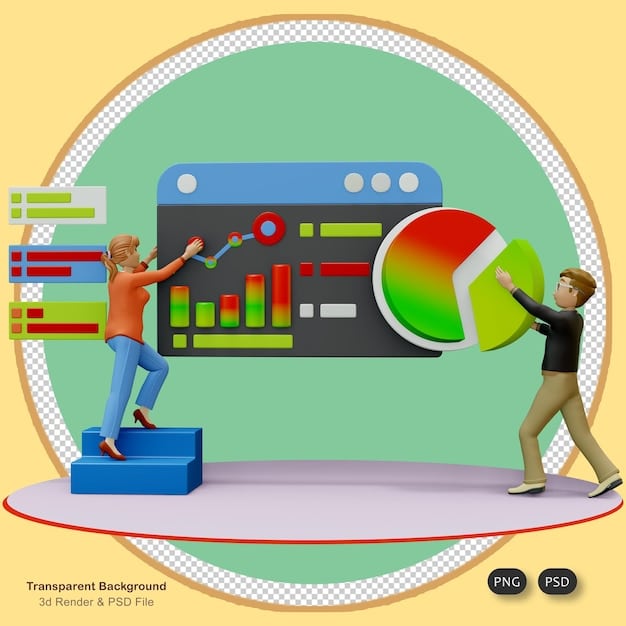Boost User Engagement: Interactive Polls in Social Media 2025

Interactive polls on social media are poised to drastically enhance user engagement in 2025, offering businesses and content creators unprecedented opportunities to connect with their audience, gather real-time feedback, and tailor content strategies for a potential 25% increase in engagement rates.
Want to skyrocket your social media engagement by 25%? Interactive polls might be your secret weapon in 2025. Let’s dive into how strategically using polls can transform passive followers into active, engaged community members.
Why Interactive Polls Are the Future of User Engagement
Interactive polls are rapidly evolving from simple marketing gimmicks to sophisticated tools for understanding and engaging audiences. In 2025, their role is expected to become even more crucial. Let’s explore what makes them so effective.
The Psychology Behind Poll Engagement
Polls naturally appeal to our desire to express opinions and feel heard. They leverage psychological principles to encourage participation.
- The Need for Validation: People enjoy seeing their views reflected in poll results.
- Easy Participation: Polls require minimal effort, unlike lengthy surveys or comments.
- Instant Gratification: The immediate feedback of poll results provides satisfaction.
Understanding these psychological drivers is key to designing polls that truly captivate your audience.
Data-Driven Decision Making
Interactive polls provide invaluable real-time data that can inform your content strategy and marketing efforts. They bridge the gap between guesswork and informed decision-making.
By analyzing poll responses, you gain direct insights into your audience’s preferences, pain points, and interests. This allows you to tailor your content, messaging, and product development accordingly, ensuring that your efforts resonate with your target audience.
In conclusion, interactive polls have evolved from simple engagement tools to essential components of a data-driven marketing strategy. As we move into 2025, understanding and leveraging their psychological appeal and data-driven capabilities will be crucial for maximizing user engagement and achieving marketing success.

Crafting Compelling Poll Questions for Maximum Response
The success of your interactive polls hinges on the quality and relevance of your questions. Here’s how to craft questions that drive participation and yield valuable insights.
Start by clearly defining your goals. What do you want to learn from your audience? Are you seeking feedback on a new product, gauging interest in a specific topic, or simply trying to spark conversation? Your objectives will guide the formulation of your questions.
Balancing Simplicity and Depth
Your questions should be easy to understand and answer, but also provide meaningful insights. Avoid overly complex or technical jargon.
Consider the language you use. Opt for clear, concise wording that resonates with your target audience. Test your questions on a small group to ensure they are easily understood and interpreted correctly.
Incorporating Visual Elements
Visuals can significantly boost engagement with your polls. Use images, GIFs, or short videos to enhance your questions and answer options.
- Increase Appeal: Visual elements make your polls more visually appealing.
- Clarify Understanding: Visuals can help illustrate complex concepts or products.
- Boost Shareability: Visually engaging polls are more likely to be shared.
Timing is Everything
Pay attention to when you post your polls. Consider your audience’s online habits and schedule your polls for times when they are most active. Experiment with different posting times to identify what works best.
In summary, crafting compelling poll questions involves a careful balance of simplicity, relevance, and visual appeal. By following these strategies, you can create interactive polls that not only capture your audience’s attention but also provide valuable insights to inform your marketing efforts and drive user engagement.
Implementing Polls Across Different Social Media Platforms
Each social media platform offers unique features and audience demographics. Tailoring your poll strategy to each platform is crucial for success.
The user expectations, trends, and platform-specific features shape social media interactions. Let’s examine how to leverage polls effectively across major platforms.
Facebook: Engaging Communities
Facebook polls are ideal for sparking conversations within groups and pages. Use them to gather opinions on community-related topics.
You can use Facebook polls within groups to foster discussions around shared interests. Polls on your business page can help you understand customer preferences and improve your products or services.
Instagram: Visual Storytelling
Instagram Stories offer a highly visual and interactive environment for polls. Use them to complement your visual content and engage followers in real-time.
- Enhance Product Launches: Use polls to tease new products and gather feedback.
- Run Contests: Create polls that allow followers to vote for their favorite entries.
- Drive Traffic: Include links in Stories to direct poll participants to your website.
X (formerly Twitter): Quick Opinions and Trending Topics
X polls are perfect for capturing quick opinions on trending topics. Use them to insert your brand into relevant conversations.
X’s real-time nature makes it a great platform for gauging public sentiment on current events. Use polls to provide updates, or gather immediate feedback during live events.

Analyzing Poll Results and Applying Insights
Collecting poll results is only half the battle. You need to analyze the data and apply the insights to your marketing strategy.
Effective analysis allows you to extract actionable information, refine your strategies, and enhance user engagement. Let’s look at techniques for maximizing the value of your poll data.
Identifying Trends and Patterns
Look for recurring themes in the poll responses. Identify demographics that consistently favor specific options.
You can use simple spreadsheet software to record poll responses. Look for correlation between responses by creating pivot tables to identify hidden correlations between variables.
Segmenting Your Audience
Use poll data to segment your audience based on their preferences and behaviors. Tailor your messaging and content to each segment.
- Personalized Campaigns: Create targeted ads and email campaigns based on poll responses.
- Customized Content: Develop specialized content that caters to the interests of each segment.
- Improved User Experience: Tailor your website and app interfaces to match user preferences.
Measuring the Impact on Engagement
Track your engagement metrics (likes, shares, comments) after implementing changes based on poll results. Determine if your efforts have led to a measurable increase in engagement.
For instance, if you used a poll to determine the most popular topics among your audience and focused on those topics and you see an increase in engagement, this validates the value of the strategy.
Leveraging Advanced Features for Enhanced Interactivity
In 2025, social media platforms offer advanced poll features that go beyond simple multiple-choice questions. Explore these features to create more engaging and interactive experiences.
Embrace these cutting-edge tools to captivate your audience, gather richer data, and foster meaningful connections.
Real-Time Polls and Live Q&A Sessions
Host live Q&A sessions where viewers can vote on questions in real-time. Answer the most popular questions live to maximize engagement.
Live, real-time polls add an element of excitement, since users can actively participate and engage in real time. This provides immediate visibility
Gamified Polls and Quizzes
Turn your polls into interactive quizzes with points and rewards. Encourage users to compete against each other and share their scores.
- Increased Participation: Gamification motivates users to participate and complete polls.
- Enhanced Data Collection: Quizzes provide deeper insights into user knowledge and preferences.
- Wider Reach: Gamified polls are more likely to be shared and go viral.
AI-Powered Polls and Sentiment Analysis
Use AI tools to analyze the sentiment behind poll responses. Gain a deeper understanding of your audience’s emotions and opinions.
AI-powered analytics can identify subtle patterns in poll responses, assess the emotional tone of comments, and predict future trends. You can use this information to create more relevant messages.
Ethical Considerations and Best Practices
Collecting and using poll data comes with ethical responsibilities. Ensure you’re adhering to privacy laws and best practices to maintain user trust.
Transparency, data security, and user consent are essential to maintaining ethical standards and building long-term relationships with your audience.
Transparency and Disclosure
Clearly disclose how you will use the poll data. Be transparent about your intentions and don’t collect more information than you need.
Inform your audience about the reasons for the poll, how the data will be utilized, and whether their responses will be anonymized or linked to their personal accounts. Transparency builds confidence and encourages participation.
Data Security and Privacy
Protect poll data from unauthorized access and breaches. Implement security measures to safeguard user information.
- Encryption: Use encryption to protect poll data in transit and at rest.
- Access Controls: Limit access to poll data to authorized personnel only.
- Regular Audits: Conduct regular security audits to identify and address vulnerabilities.
User Consent and Control
Obtain explicit consent from users before collecting their data. Give them the option to opt out of data collection and allow them to access and delete their data.
Ensure that your polls adhere to all relevant data privacy regulations, such as GDPR and CCPA. Provide users with easy-to-understand privacy policies and clear mechanisms for exercising their rights.
| Key Aspect | Brief Description |
|---|---|
| 📊 Poll Creation | Design polls with clear, visually engaging questions for maximum responses. |
| 🎯 Audience Segmentation | Segment users based on poll responses to tailor content and marketing. |
| 🤖 AI Analysis | Utilize AI for sentiment analysis to understand deeper audience insights. |
| 🔒 Data Ethics | Ensure transparency and protect user data to maintain trust. |
FAQ
Interactive polls boost engagement by inviting participation and making users feel their opinions are valued. This encourages active interaction and increases time spent on platforms.
Facebook, Instagram, and X are ideal for polls. Each platform offers unique poll features and audience demographics. Tailor your polls to the specific platform’s environment.
A compelling poll question is simple, clear, and relevant to your audience. It involves language they understand and has visuals to make it more engaging.
Look for trends, segment your audience based on their preferences, and measure the impact of your poll data on engagement metrics. Track likes and shares after making changes.
Be transparent about the use of collected data. Ensure you maintain privacy through security, and that you provide user consent and control to opt out of data collection.
Conclusion
As we look toward 2025, the strategic integration of interactive polls on social media platforms emerges as a pivotal strategy for those aiming to elevate user engagement, enabling more dynamic and insightful interactions. By adhering to best practices, understanding platform nuances, and prioritizing user privacy, businesses can harness the full potential of polls to increase engagement and foster lasting connections with their audience.





